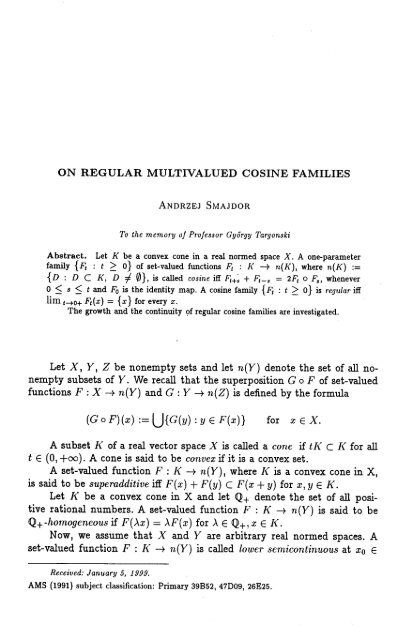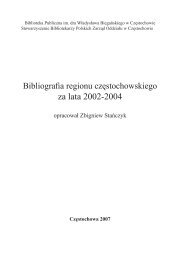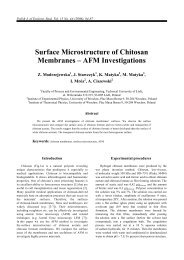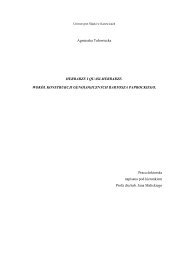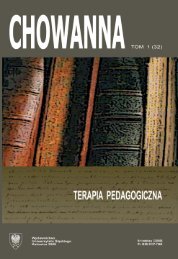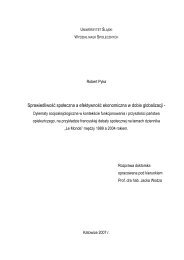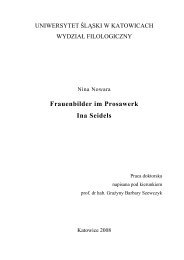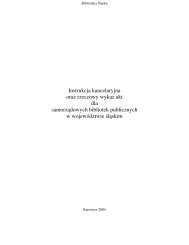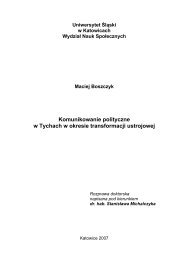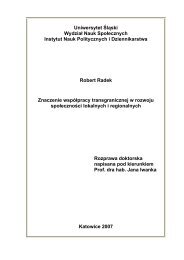ON REGULAR MULTIVALUED COSINE FAMILIES Let X, Y, Z be ...
ON REGULAR MULTIVALUED COSINE FAMILIES Let X, Y, Z be ...
ON REGULAR MULTIVALUED COSINE FAMILIES Let X, Y, Z be ...
You also want an ePaper? Increase the reach of your titles
YUMPU automatically turns print PDFs into web optimized ePapers that Google loves.
<strong>ON</strong> <strong>REGULAR</strong> <strong>MULTIVALUED</strong> <strong>COSINE</strong> <strong>FAMILIES</strong>ANDRZEJ SMAJDORTo the memory of Professor Győrgy TargonskiAbstract. <strong>Let</strong> K <strong>be</strong> a convex cone in a real normed space X. A one-parameterfamily {F t: t > o} of set-valued functions F t: K —> n(K), where n(K) :={D : D C A', D jl 0}, is called cosine iff F i+S+ F,_ s= 2F to F s, whenever0 < s < t and F 0is the identity map. A cosine family {F t: t > o} is regular ifflim f-».o+ F t(x) = {1} for every x.The growth and the continuity of regular cosine families are investigated.<strong>Let</strong> X, Y, Z <strong>be</strong> nonempty sets and let n(Y) denote the set of all nonemptysubsets of Y. We recall that the superposition G o F of set-valuedfunctions F : X —> n(Y) and G : Y —¥ n(Z) is denned by the formula(GoF)(x) :=(J{G(y):y£F(x)} for x £ X.A subset K of a real vector space X is called a cone if tK C K for allt € (0, +oo). A cone is said to <strong>be</strong> convex if it is a convex set.A set-valued function F : K —>• n(Y), where is a convex cone in X,is said to <strong>be</strong> superadditive iff F(x) + F(y) C F(x + y) for x,y £ K.<strong>Let</strong> A' <strong>be</strong> a convex cone in X and let Q +denote the set of all positiverational num<strong>be</strong>rs. A set-valued function F : K -> n(Y) is said to <strong>be</strong>Q +-homogeneous if F(Xx) — \F{x) for A € Q +, a; G A'.Now, we assume that X and F are arbitrary real normed spaces. Aset-valued function F : K —> n(Y) is called /ou>er semicontinuous at XQ 6Received: January 5, 1999.AMS (1991) subject classification: Primary 39B52, 47D09, 26E25.
272 Andrzej SmajdorK iff for every open set V in Y such that F(x 0) C\V ^ 0 there exists aneighbourhood U of zero in X such that F(x) D V ^ 0 for x 6 (x 0+ U) D/
On regular multivalued cosine families273The set of all nonempty bounded subsets of a normed space Y will <strong>be</strong>denote by 5(F).LEMMA 3 (Theorem 3 in [7]). <strong>Let</strong> X arid Y <strong>be</strong> two real normed spacesand let K <strong>be</strong> a convex cone in X. Suppose that (F,- : i £ /) is a family ofsuperadditive lower semicontinuous in K and Q+-homogeneous set-valuedfunctions Fj : K —> n(Y). If F(x) = {J ieIF,(x) and the set B = {x £ K :F(x) £ B(Y)} is of the second category in A, then F is bounded and B = A'.Lemma 3 and the same considerations as in the proof of Theorem 4 in[7] allow to derive the following lemma.LEMMA 4. <strong>Let</strong> X and Y <strong>be</strong> two real normed spaces and let K <strong>be</strong> aconvex cone in X. Suppose that (F; : i £ I) is a family of superadditivelower semicontinuous in A' and Q +-homogeneous set-valued functions F; :A —>• n(Y). If K is of the second category in K and Uie/ Fi{ x ) 6 B(Y) forx £ A', then there exists a constant M £ (0, +oo) such thatsup \\Fi(x)\\ < M\\x\\ for x £ A'.ieiREMARK 1. The assumption that the cone A' is a set of the secondcategory in A' is essential and it can not <strong>be</strong> replaced by the completnessof X.In order to prove it we use an example from Chapter III, §3.7 ofN. Bourbaki's book [ll. <strong>Let</strong> X — {x £ C(R,R) : lim x(t) = lim x{t) =0}, ||x|| = sup{|x(i)| : t £ R} for x £ X and let A = {x £ X : supp x £c(R)}, where c(R) is the set of all nonempty compact subsets of the set R ofall real num<strong>be</strong>rs. We can check that in this case (X, \\ ||) is a Banach space,A' is a convex cone and set-valued functions F; : A' —> n(R), i — 1,2,...defined by formulasFi{x) = {ix(t)}are additive, continuous and are Q +-homogeneous in A'. Moreover, sets|jF i(a;) = {ża:(t):t€N}are finite. So almost all assumptions of Lemma 4 hold except the "category"assumption. <strong>Let</strong> functions XJ, i £ N <strong>be</strong> defined as follows0, if -oo
274Andrzej SmajdorWe see that every x 2- <strong>be</strong>longs to A, Fi(xi) = {i} and ||ar,-|| = 1 for everyi £ N. Therefore the assertion of Lemma 4 does not hold.REMARK 2. A convex cone K in Lemma 4 is of the second category inK if one of the three following cases holds true:a) X is a Banach space and intA ^ 0,b) X is a Banach space and K is closed,c) X is a normed space and dim A — dim (K - K) < +oo.Cases a) and b) are obvious. In case c), let n = dim (A' - A). Thenthere exist a basis {ci - d\,c„ - d n] of lin A = K - A, such that theset {ci, ...c n, di, ...d n} is a subset of A'. This subset is a spanning set ofK - A', therefore it contains a basis {ei,e,J C K of A' - A'. The formula\\x\\ = Y^i=z\ If iii f° r x — fi e i + ••• + fn^m defines a norm in A - A. It iseasy to check that the ball B(x 0,r 0) centered at x 0= + ... + ^e nwiththe radius r 0= ^ is a subset of A. So the interior of K is nonempty.<strong>Let</strong> T and 5 <strong>be</strong> two metric spaces and let c(S) denote the set of allcompact elements of n(S). The Hausdorff distance derived from the metricin S is a metric in c(5). A set-valued function F : T —> c(S) is said to <strong>be</strong>continuous iff it is continuous as a single-valued function from T into themetric space c(5).<strong>Let</strong> Y <strong>be</strong> a normed space. We denote by cc(Y) the family of all convexmem<strong>be</strong>rs of c(Y). Observe that each linear set-valued function with closedvalues has to have convex ones.LEMMA 5. <strong>Let</strong> X and Y <strong>be</strong> two real normed spaces and let d <strong>be</strong> theHausdorff distance derived from the norm in Y. Suppose that K is a convexcone in X with nonempty interior. Then there exists a positive constant Mosuch that for every linear continuous set-valued function F : A" —> c(Y) theinequalityd(F(x),F(y))
On regular multivalued cosine families275for A > 0 andfor A < 0.The functionalX[A, B] = [-XB, -XA]\\[A,B]\\:= d(A, £),is a norm in Z (see [5]).Now, let F : K —> c(Y) <strong>be</strong> a linear continuous set-valued function. Thenthe function / : K —• Z given byf(x) = [F(x),{0}},is linear. Moreover, let x 0G K and (x n) <strong>be</strong> a sequence of elements of K suchthat XQ — lim n->oo s-n- Then F(a;o) =li m n-+ooF(x„) andlim ||/(a:n)-/(so)||= Hm d(F(x n), F(x 0)) = 0,n—>con-+ooso / is continuous. The function / can <strong>be</strong> extended to a linear function/ : X —• Z. This function'is also continuous. Thereforelim f(x) = lim f(x) = /(0) = 0andlim d(F(x), {0}) = lim \\[F(x), {0}]|| = lim ||/(z)|| - 0.By Lemmas 1 and 2, F and / are bounded. Fix a z e intft'. There existsan € > 0 such that \z + S C where 5 is the closed unit ball in X. Ifv e S and w = \z + v, then u € K and ||«|| < ||\z\\ + 1, therefore w e n a v e- /Mil = Ik - 2/llll/(pffji)H < ll/IMI* - y||,where M 0:= 1 + 2||^||. This implies thatd(F(x), F(y)) = ||[F(*), F(y)}\\ = \\f(x) - /(y)|| < M 0||F||||* - y\\.18 *
276Andrzej SmajdorThis is a stronger version of Lemma 16 in [3](see also Lemma 7 in [4]).The application of the Radstrom's equivalence relation allows to omit theassumption that X is a separable Banach space. This is an idea of dr JoannaSzczawińska.LEMMA 6 (Lemma 1.9 in [6]). <strong>Let</strong> X <strong>be</strong> a metric space with a metric pand let F <strong>be</strong> a set-valued function from X into X. If for a positive num<strong>be</strong>rM the inequalityholds for every x, y € X, thend(F(x),F(y)) 0} ofset-valued functions F t: K —> n{K) is said to <strong>be</strong> a cosine family iffF 0= /,where / denotes the identity map and(2) F t+s+ F t_ s= 2F toF s,whenever 0 < s < t.EXAMPLES:1. K = (—oo, +oo), F t(x) — x[cost,cosht],2. K = (—co, +oo), Ft{x) — x[cosi, 1].3. K = [0,-r-co), F t(x) = x[l,cosht].<strong>Let</strong> X <strong>be</strong> a real normed linear space. A cosine family {F t: t > 0} isregular iff\\m +d(F t(x),{x}) = 0,where d is the Hausdorff distance derived from the norm in X.THEOREM 1. <strong>Let</strong> X <strong>be</strong> a real normed space, and let K <strong>be</strong> a convex conein X of the second category in K. If {F t: t > 0} is a regular cosine familyof continuous superadditive Q^-homogeneous set-valued functions F t: K —>c(A'), then there exist two constants M > 0 and u > 0 such that||F^l < Me ul for t > 0.
On regular multivalued cosine families 277PROOF. The proof will <strong>be</strong> divided into three steps.1° There exists an n, 0 < n < 1 such that the function t t-» ||Ff|| isbounded for 0 < t < n.Suppose that it is false. Then there is a sequence (t n) satisfying conditions:t n> 0, lim n-too t n= 0 and \\F tn\\ > n for n = 1, 2,... . From Lemma4 it follows that for some x G K the sequence (||F TN(x)\\) is unbounded contraryto the regularity of the family {F t: t > 0}. Thus there exist an r/,0 < t] < 1 and L > 0 such thatIIFII < L for i € [0,r,].Since ||F 0|| = ||/|| = 1 we have L > 1.2° <strong>Let</strong> m > 1 <strong>be</strong> an arbitrary constant. If s > 0 and \\F S\\ < m, then forevery n = 1,2,... we have \\F ns\\ < (3m) n .The proof is by induction on n. The case n = 1 is trivial. If n = 2 weobtainll*2.|| < + 2||F S|| 2 < 2m 2 + 1 < (3m) 2 .Now, we suppose that n > 3 and\\F ks\\ < (3m) fcfor\
278 Andrzej SmajdorA cosine family {F t: i > 0} is continuous iff the function t H-> F t(x) iscontinuous for every x 6 K.THEOREM 2. <strong>Let</strong> X <strong>be</strong> a real Banach space and let K <strong>be</strong> a convex cone inX such thatmtK ^ 0. If{F t: t > 0} is a regular cosine family of continuousadditive set-valued functions F t: K —¥ cc{K), then it is continuous.PROOF. The proof will <strong>be</strong> divided into eight steps.1° We assume that there exist XQ € K and t 0€ [0, +oo) such that thefunction t H-> F t(xo) is discontinuous at the point to- Since the consideredcosine family is regular, to is positive.2° <strong>Let</strong> us defineL n:= sup{d(F t(xo),F s(x 0)) : |t-t 0| < ^-,|s-*o| < A * > 0, s > 0}.for every positive integer n.3° There exists L > 0 such that L n> L for every n.Obviously (L„) is a non-negative and non-increasing sequence. Hencethere exists aL = lim L n€ K.We see that L n> L for any n. Suppose that L — 0. For every e > 0 thereexists a positive integer n such thatd(F t(a:o), ^fao)) < e,whenever \t - t 0| < \s - t 0\ < |£, t > 0 and s > 0. This implies thatthe function t i-» F t(xo) is continuous at t 0contrary to our assumption 1°.Therefore L > 0 and we take L = L.4° For every positive integer n there exist two positive num<strong>be</strong>rs s andt such that \s - t 01 < |t - to I < & and d(F t(x 0), F s{x 0)) > L n- £ > 0.Hence t ^ s. Therefore there exist two sequences (t n) and (s„) such thats n> t n> 0, \t n-t 0\ < g£, |sn-*o| < & and d(F tn(xo), F Sn(x 0)) > - £for every n.5° 2t„ — s n€ (0, +oo) for every n.It suffices to show that t n> s n- t nBy 4° clearly«n - = (-Sn ~ to) + (to ~ *n) < ~r~and*n — £o — (^0 — ^n) >8n- 18n
On regular multivalued cosine families 2796°for every n — 1,2,....From 4° we have \s in- t 0\ < < j£ and |(2i 4n - *4n) - *o| =|2(*4n - *0) + (*0 - *4n)| < 2|t 4n - *o| + 1*0 ~ *4n| < |&
280 Andrzej SmajdorREMARK 3. In the proof of Theorems 1 and 2 we have essentialy usedideas of M. Sova [8] for cosine operator functions.REFERENCES[1] N. Bourbaki, Elements de Mathematique, Livre V, Espaces Vectoriels Topologiques, Paris1953-1955.[2] E. Hille, R. S. Phillips, Functional Analysis and Semigroups, Providence, Rhode Island1957.[3] J. Olko, Rodziny wielowartościowych funkcji liniowych, doctoral dissertation.[4] J. Olko, Semigroups of set-valued functions, Publ. Math. 51 (1997), 81-96.[5] H. Radstrom, An em<strong>be</strong>dding theorem for space of convex sets, Proc. Amer. Math. Soc. 3(1952), 165-169.[6] A. Smajdor, Iteration of multivalued functions, Prace Naukowe Uniwersytetu Śląskiego wKatowicach nr 759, Uniwersytet Śląski, Katowice 1985.[7] W. Smajdor, Superadditive set-valued functions an Banach-Steinhaus theorem, RadoviMat. 3 (1987), 203-214.[8] M. Sova, Cosine operator functions, Rozprawy Mat. 49 (1966), 1-47.PEDAGOGICAL UNIVERSITYPODCHORĄŻYCH 2PL-30-084 KRAKÓWPOLAND


